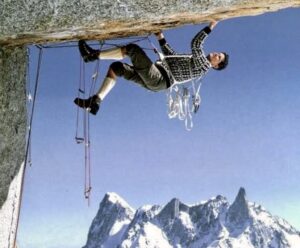It’s ironic but all too common that someone renowned for safety and competence in hairy outdoor settings sustains the worst injury of their life back in civilization. On vacation in Saskatchewan earlier this month, Canadian alpinist Barry Blanchard fell down a flight of concrete stairs and suffered serious head trauma.
Now, the extent of the famed climber’s injuries is becoming clear. Reports indicate that he’s making progress, but his family has emphasized the importance of patience for what will likely be a long road.
The 62-year-old climbing guide sustained moderate brain trauma with multiple facial fractures in the incident. Medical professionals identified numerous brain bleeds. Blanchard’s family says that he’s having trouble communicating and has lost most of his memory.

Blanchard traverses the Cassin Ridge of Denali, 1982. Photo: Doyle/Creative Commons
The following, from a statement issued by his family on August 11, might be the most cogent explanation of Blanchard’s condition.
At this point his history is obsolete and it will take a long rehabilitation to remember the events of his life, work, experiences, friends, technology, etc. Barry is recognizing family members, his daughters, and his partner in life. His recovery is going well, however, his injury needs to be put into perspective so that people can adjust their expectations. For example: he is unable to pick up a phone, form a complete thought or send a text. Everyday tasks will need to be relearned and this will take time.
According to a fundraiser started by friends to support his recovery, none of his injuries require surgery. But he will spend an extended stretch in the hospital recovering basic faculties.
Barry Blanchard’s climbing career
Blanchard first built his reputation in the 1980s, with difficult and committing ascents in the Canadian Rockies. In 1983, he, David Cheesmond, and Tim Friesen pioneered the world-class 600m Andromeda Strain (5.11a WI4+, M6) on Mount Andromeda. Blanchard continued developing routes through the 1990s and 2000s, including the 2002 FA of Infinite Patience on the Emperor Face of the Canadian Rockies’ highest peak, Mount Robson.
He also climbed prolifically in the Karakorum and Himalaya, regularly ticking first ascents into the early 2000s with the likes of Mark Twight.
Eventually, his guiding career made him beloved by many, especially in his home of Canmore, Alberta. And he leveraged his experience to help in the production of Hollywood climbing movies like Cliffhanger and The Vertical Limit. Like most of the real alpinists behind the scenes in such films, he had an amused perspective on how Hollywood presented climbing.
He was an active climber until his recent accident.
Outlook and fundraiser
Though Blanchard’s path to recovery looks long, he doesn’t appear to be in immediate danger. Anyone interested in supporting him can visit the Help Barry Blanchard Recover fundraiser page, organized by his friend Jesse De Montigny.
Recently, he was moved from Regina, Saskatchewan, where the accident took place, to his home hospital in Canmore, Alberta.






